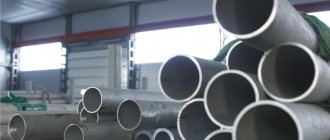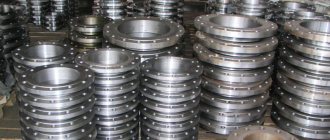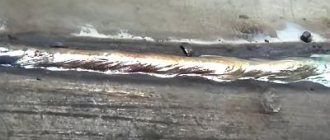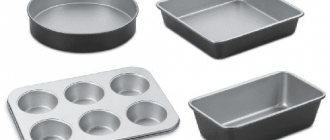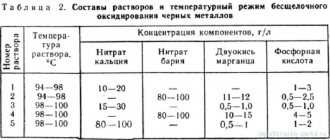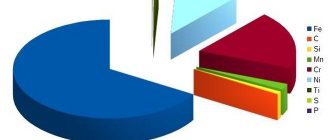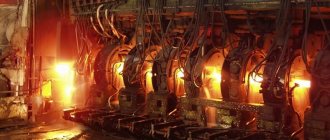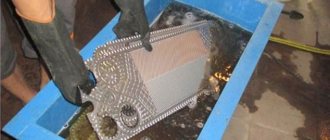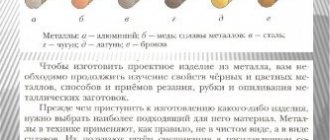Density (P) is a physical quantity that is determined for a homogeneous material or substance by its mass (in g, kg or t) per unit volume (1 mm 3, 1 cm 3 or 1 m 3). That is, it is calculated by dividing the mass by the volume in which it is contained. The result is a certain quantity, which for each material and substance has its own value, varying depending on the temperature. Density is also called specific gravity. Using this term, it is easier to understand the essence of this characteristic. That is, it is the mass possessed by a unit volume of a material or substance.
And to calculate the theoretical (calculated nominal) weight of 1 linear or square meter of any metal product, this physical quantity is used - density, of course, for the corresponding metal. And in all GOST standards for the assortment, where the main characteristics of rolled products are given, after the tables that list the theoretical masses of 1 linear or square meter of products of different standard sizes, it is necessary to indicate exactly what density value was taken in the calculation. Why and when it is necessary to find out the weight of 1 meter of metal products is known to everyone who needs it. This parameter is used to calculate the total mass of one product or an entire batch based on their total length or area. But why and when do you need to know the density of steel, in particular stainless steel?
The fact is that for all types of metal products, the theoretical mass of 1 meter given in GOSTs and reference books was calculated using one or another average density value. For rolled steel, the most common indication is 7850 kg/m 3 or 7.85 g/cm 3, which is the same thing. And the actual P of steel, depending on the alloy used for the production of the product, can vary from 7600 to 8800 kg/m 3.
If you wish, it is easy to calculate what the error will be if you calculate the mass of a corner (or a product of another type of rolled steel) made not from carbon or other steel with a density of 7850 kg/m 3, but from another heavier one (for example, steel 12Х18Н10Т) or light alloy. For small volumes of rolled products, and when precise determination of weight is not required, the difference will be insignificant. That is, an approximate calculation of the total mass of metal products based on tabular data from GOST on the weight of 1 meter will be justified. In addition, during shipment, as a rule, weighing is done to determine the actual weight of the products for the accuracy of mutual settlements between the supplier and the buyer.
But it is often necessary to know the exact, albeit theoretical, weight at the stage of placing an order for the supply of rolled products, and for design and design calculations this is a prerequisite. It is in such cases that the density of the alloy from which the metal product is made is determined, and then, based on these data, an adjustment is made to the mass of 1 meter taken from GOST. And only then the total weight of the rolled product is calculated. How to adjust the weight of 1 meter is discussed below.
Specific heat capacity of common grades of steel
The summary table shows the specific heat capacity of steel of common grades: carbon, low- and high-alloy steels, as well as cast iron at different temperatures.
The values of the average specific heat capacity of low-alloy steels and carbon steels at various temperatures are given, and the heat capacity of high-alloy steels with special properties depending on temperature is indicated.
The table shows that the specific heat capacity of steel increases with increasing temperature.
It should be noted that the heat capacity of steel at room temperature ranges from 440 to 550 J/(kg deg); The specific heat capacity of steel in the table is presented in the temperature range from 20 to 1000°C. Specific heat capacity of steel at different temperatures
| steel grade | Temperature, °C | Heat capacity of steel, J/(kg deg) |
| 02Х17Н11М2 | 20…400…600…800 | 470…560…610…650 |
| 02X22N5AM3 | 20…100…200…300…400 | 480…500…530…550…590 |
| 03X24N6AM3 (ZI130) | 20…100…200…300…400 | 480…500…530…550…570 |
| 05ХН46МВБЧ (DI65) | 100…200…300…400…500…600…700…800 | 445…465…480…490…500…510…515…520 |
| 06Х12Н3Д | 100…200…300…400 | 523…544…577…594 |
| 07Х16Н6 (Х16Н6, EP288) | 100…200…300…400…500…600…700 | 440…500…550…590…630…670…710 |
| 08 | 100…200…400…600 | 465…477…510…565 |
| 08kp | 100…200…300…400…500…600…700…800…900 | 482…498…514…533…555…584…626…695…695 |
| 08Х13 (0Х13, EI496) | 20 | 462 |
| 08Х14МФ | 20…100…200…300…400…500…600 | 460…473…502…540…574…682…754 |
| 08Х17Т (0Х17Т, EI645) | 20 | 462 |
| 08Х17Н13М2Т (0Х17Н13М2Т) | 20 | 504 |
| 08Х18Н10 (0Х18Н10) | 20 | 504 |
| 08Х18Н10Т (0Х18Н10Т, EI914) | 20…100…200…300…400…500…600…700 | 461…494…515…536…549…561…574…595 |
| 08GDNFL | 100…200…300…400…500…600…700…800…900 | 483…500…517…529…554…571…613…697…693 |
| 09X14N19V2BR1 (EI726) | 20 | 502 |
| 015Х18М2Б-VI (EP882-VI) | 100…200…300…400 | 473…519…578…636 |
| 1Х14Н14В2М (ЭИ257) | 20…100…200…300…400…500…600…700 | 461…486…515…536…544…557…590…624 |
| 4Х5МФ1С (EP572) | 20…100…200…300…400…500…600…700…800 | 431…477…519…565…620…703…888…766…749 |
| 10 | 100…200…400…600 | 465…477…510…565 |
| 10kp | 100…200…400…600 | 466…479…512…567 |
| 10Kh12N3M2FA(Sh) (10Kh12N3M2FA-A(Sh)) | 100…200…300…400…500 | 510…538…562…588…627 |
| 10Х13Н3М1Л | 20 | 495 |
| 10Х17Н13М2Т (Х17Н13М2Т, EI448) | 20 | 504 |
| 10Х17Н13М3Т (Х17Н13М3Т, EI432) | 20 | 504 |
| 10Х18Н9Л | 100 | 504 |
| 10GN2MFA, 10GN2MFA-VD, 10GN2MFA-Sh | 100…200…300…400 | 469…553…599…628 |
| 12MH | 20…200…300…400…500…600…700 | 498…519…569…595…653…733…888 |
| 12X1MF (EI575) | 100…200…300…400…500…600…700…800 | 507…597…607…643…695…783…934…1025 |
| 12Х13 (1Х13) | 20…100…200…300…400…500…600…700…800 | 473…487…506…527…554…586…636…657…666 |
| 12X13G12AS2N2 (DI50) | 100…200…300…400…500…600…700 | 523…559…602…613…648…668…690 |
| 12Х18Н9 (Х18Н9) | 20 | 504 |
| 12Х18Н9Т (Х18Н9Т) | 20…100…200…300…400…500…600…700…800 | 469…486…498…511…519…528…532…544…548 |
| 12Х18Н12Т (Х18Н12Т) | 20…100…200…300…400…500…600…700 | 461…494…515…540…548…561…574…595 |
| 14Х17Н2 (1Х17Н2, EI268) | 20 | 462 |
| 15 | 100…200…400…500 | 469…481…523…569 |
| 15G | 100…300…500 | 496…538…592 |
| 15K | 100…200…400…500 | 469…482…524…570 |
| 15kp | 100…200…300…400…500…600…700…800 | 465…486…515…532…565…586…620…691 |
| 15L | 100…200…400…600 | 469…477…515…570 |
| 15Kh2NMFA-A, 15Kh2NMFA-A class 1 | 100…200…300…400 | 490…515…540…569 |
| 15X11MFBL (1X11MFBL, X11LA) | 100…200…300…400…500…600 | 494…528…574…641…741…867 |
| 15Х25Т (Х25Т, EI439) | 20 | 462 |
| 15ХМ | 100 | 486 |
| 17Х18Н9 | 20 | 504 |
| 18Kh11MNFB (2Kh11MNFB, EP291) | 100…200…300…400…500…600 | 490…540…590…666…766…900 |
| 18ХГТ | 100…200…300…400…500…600…700…800 | 495…508…525…537…567…588…626…705 |
| 20 | 100…200…400…500 | 469…481…536…569 |
| 20G | 100…200…400…500 | 469…481…536…569 |
| 20GSL | 100…200…400…500 | 469…482…536…569 |
| 20K | 100…200…400…500 | 469…482…524…570 |
| 20L | 100…200…400…600 | 469…481…536…570 |
| 20kp | 100…200…300…400…500…600…700…800…900 | 486…498…514…533…555…584…636…703…695 |
| 20HML | 100…200…300…400…500 | 498…572…588…612…660 |
| 20ХМФЛ | 100…200…300…400…500…600 | 498…574…590…615…666…741 |
| 20Х3МВФ (EI415, EI579) | 100…200…300…400…500…600 | 502…561…611…657…716…754 |
| 20Х23Н13 (Х23Н13, EI319) | 20 | 538 |
| 20Х23Н18 (Х23Н18, EI417) | 20 | 538 |
| 20ХН3А | 100…200…300…400…500…600…700…800 | 494…507…523…536…565…586…624…703 |
| 22K | 100…200…400…500 | 469…481…519…569 |
| 25 | 100…200…400…500 | 469…482…524…570 |
| 25L | 100…200…400…600 | 469…481…519…570 |
| 25Х1МФ | 20 | 461 |
| 25Х2М1Ф (EI723) | 100…200…300…400…500…600 | 536…574…607…632…674…733 |
| 25ХГСА | 20…100…200…300…400…500…600…700 | 496…504…512…533…554…584…622…693 |
| 30 | 100…200…300…400…500 | 469…481…544…523…762 |
| 30G | 100…200…300…400…500 | 469…481…544…599…762 |
| 30L | 100…200…400…600 | 469…481…523…570 |
| 30Х13 (3Х13) | 20…100…200…300…400…500…600…700…800 | 473…486…504…525…532…586…641…679…691 |
| 30ХГТ | 100…200…300…400…500…600…700…800 | 495…508…525…537…567…588…626…705 |
| 30X | 20…100…200…300…400…500…600…700…800…900 | 482…496…513…532…555…583…620…703…687…678 |
| 30ХН2МВА (30ХН2МВА) | 20…100…200…300…400 | 466…508…529…567…588 |
| 30ХН3А | 100…200…300…400…500…600… 700…800…900…1000 | 494…504…518…536…558…587… 657…703…695…687 |
| 33ХС | 20…100…200…300…400…500…600…700 | 466…508…529…563…599…622…634…664 |
| 35 | 100…200…400…500 | 469…482…524…570 |
| 35L | 100…200…400…600 | 469…481…523…574 |
| 35ХГСЛ | 100…200…300…400…500…600…700…800…900 | 496…504…512…533…554…584…622…693…689 |
| 35HML | 100…200…300…400…500…600…700…800…900 | 479…500…512…529…550…580…617…689…685 |
| 36Х18Н25С2 (4Х18Н25С2, ЭЯ3С) | 20 | 515 |
| 40 | 100…200…300…400…600 | 469…481…519…523…574 |
| 40G | 100…200…400…600 | 486…481…490…574 |
| 40L | 100…200…400…600 | 469…481…523…574 |
| 40Х10С2М (4Х10С2М, EI107) | 300…400…500 | 532…561…586 |
| 40Х13 (4Х13) | 20…100…200…300…400…500…600…700…800 | 452…477…502…528…553…578…620…666…691 |
| 40HL | 100…200…300…400…500…600…700…800…900 | 491…508…525…538…569…588…626…701…689 |
| 45 | 100…200…400…500 | 469…482…524…574 |
| 45G2 | 100…200 | 444…427 |
| 45L | 100…200…400…600 | 469…481…523…569 |
| 45Х14Н14В2М (ЭИ69) | 300…400…500…600 | 507…511…523…528 |
| 50 | 300…400…500 | 561…641…787 |
| 50G | 20…100…200…300…400…500…600…700 | 487…500…517…533…559…584…609…676 |
| 50L | 100…200…400…600 | 478…511…511…569 |
| 55 | 100…200…400…500 | 477…486…523…569 |
| 60 | 100…200…400…600 | 481…486…528…565 |
| ХН35ВТ (ЭИ612) | 100…200…300…400…500…600 | 511…544…569…590…595…595 |
| KHN64VMKYUTL (ZMI3) | 20…100…200…300…400…500…600… 700…800…900…1000 | 430…450…470…490…515…540…565… 590…625…650…1008 |
| KHN65VKMBYUTL (EI539LMU) | 20…100…200…300…400…500…600… 700…800…900…1000 | 424…436…480…493…505…518…548… 596…650…692…710 |
| KHN65VMTYUL (EI893L) | 20…100…200…300…400…500…600…700…800 | 425…430…440…470…500…510…550…615…650 |
| KHN65KMVYUTL (ZhS6K) | 20…100…200…300…400…500…600…700…800…900 | 380…400…420…445…470…485…515…560…610…660 |
| ХН70БDT (EK59) | 100…200…300…400 | 450…475…500…505 |
| KHN70KVMYUTL (TsNK17P) | 20 | 440 |
| KhN80TBYuA (EI607A) | 100…200…300…400…500…600 | 494…547…607…678…749…829 |
| Х15Н60-Н | 20 | 460 |
| Х20Н80-Н | 20 | 460 |
| Х23У5Т | 20…800 | 480…750 |
| Х27У5Т | 20…800 | 500…690 |
| A12 | 100…300…400…600 | 469…477…515…569 |
| R6M5 | 100…200…300…400…500…600…700 | 440…470…500…550…580…670…900 |
| P18 | 100…200…300…400…500…600…700 | 420…450…470…510…550…610…690 |
| U8, U8A | 20…100…200…300…400…500…600…700…800…900 | 477…511…528…548…565…594…624…724…724…703 |
| U12, U12A | 20…100…200…300…400…500…600…700…800…900 | 469…503…519…536…553…720…611…712…703…699 |
Classification and types
Steel is classified according to its chemical composition, the content of additives, the manufacturing method, the level of deoxidation and other groups.
According to the chemical composition, it can be carbon and alloyed. In carbonaceous, in addition to carbon and iron, there is silicon (up to 0.3%) and manganese (up to 1.1%).
To impart special qualities, alloying additions (usually metals) are introduced into the alloy: chromium, aluminum, titanium, nitrogen, phosphorus, silicon, carbon, boron, etc.
Low-carbon high-quality structural steels, by definition, have low strength and high ductility.
Medium-carbon high-quality (St 30−55) are used after surface hardening and normalization to create parts with high core strength. St 60 - St 85 have greater strength, wear resistance, and elasticity properties.
High-quality has a complex chemical composition with a reduced proportion of phosphorus and sulfur. Steel of ordinary quality (carbon fraction less than 0.6%) is designated St 1−6. The symbols “St” indicate a material of normal quality, and the numbers indicate the marking number based on the properties.
In high-quality steel, the proportion of carbon is given in hundredths of a percent; in addition, the nature of hardening and the level of deoxidation can be indicated. It is characterized by a high level of weldability and great ductility.
Based on the level of deoxidation, it is divided into the following types:
- Calm (St3sp) - complete deoxidation with a minimum of impurities and slags contained in it.
- Semi-quiet (St3ps) - obtained by deoxidation of liquid metal, less complete than when smelting calm, but more than when making boiling.
- Boiling (08kp) - unoxidized with a high content of non-metal inclusions.
According to the area of application, steel can be construction, tool, structural and alloyed.
Construction grade has excellent weldability. The number shows the conditional number of the composition according to GOST. The higher it is, the stronger the alloy (for example, cast iron) and the less its ductility.
Alloyed - universal , which contains special impurities. It contains more than 0.6% silicon and 0.9% manganese. If the content of the alloying component is above 1.5%, then it is written with a number following a certain letter:
- Low alloy - alloying components up to 2.4% (09G2S, 18HGT, 10HSND). It is distinguished by great strength due to the increased viscosity limit, which is extremely necessary for structures of great responsibility.
- Medium alloyed (from 2.4 to 10%).
- Highly alloyed (from 10 to 50%).
Steel 09G2S is used for steam equipment operating at temperatures from -70 to +450°C and pressure, as well as for critical welded sheet structures in oil and chemical engineering, and shipbuilding.
Steel 10HSND is used for welded structures in chemical engineering, profiles in car building, and ship building. 18ХГТ is used for elements that operate at high speeds, loads and pressure.
Special purpose steel is an alloy with special physical properties. Used in the electrical industry and precision shipbuilding.
According to standardized parameters, it is divided into categories: from 1 to 5. They denote the chemical composition, ultimate viscosity, and tensile mechanical properties. For example, category 1 - we do not standardize the chemical composition, category 3 - has a standardized maximum viscosity at t = +20°C. For St0, neither the chemical composition nor the impact fluidity are standardized.
Average specific heat capacity of low-alloy steels
The table shows the mass specific heat capacity of low-alloy steels. The heat capacity values are given for the following steel grades: steel 30Х, 30Н3, 30ХН3, 30Г2, 50С2Г. The specific heat capacity of steels in the table is expressed in kJ/(kg deg) and is indicated depending on the temperature - in the range from 50 to 1300°C.
Specific heat capacity of carbon steels and cast iron at different temperatures
The table shows the values of the specific (mass) heat capacity of the following carbon steels and cast iron: steel 08, art. 20, art. 35, art. U8, electrical sheet steel, white cast iron, SCh10 cast iron. The heat capacity is presented in the table in the temperature range from 80 to 1573 K in the dimension kJ/(kg deg).
Instructions for calculating the parameter
Calculate with
The substance is quite simple and to do this you need to follow these steps:
- Take the calculation formula: Heat capacity = Q/(m*∆T)
- Write down the original data.
- Substitute them into the formula.
- Carry out the calculation and get the result.
As an example, let’s calculate an unknown substance weighing 480 grams with a temperature of 15ºC, which, as a result of heating (supplying 35 thousand J), increased to 250º.
According to the instructions given above, we perform the following actions:
Let's write down the initial data:
- Q = 35 thousand J;
- m = 480 g;
- ΔT = t2–t1 =250–15 = 235 ºC.
We take the formula, substitute the values and solve:
c=Q/(m*∆T)=35 thousand J/(480 g*235º)=35 thousand J/(112800 g*º)=0.31 J/g*º.
Specific heat capacity of alloy steels at different temperatures
The table shows the values of the mass specific heat capacity of steel of the following grades: steel 15L, 25L, 45L, 55L, 13N2ХА, R18, 11R3AM3F2, R6M5, 4Х13, 1Х12В2МФ, Х5М, 30ХМ, 30ХМА, 30ХГС, 30ХГСА, 1Х11МФ, 1Х12В IMF, 25Х2МФА, ХН35ВТ ( EI612, EI612K), Kh17N13M2T (EI448), Kh16N25M6 (EI395), Kh22N26, VZh100, ShH15. The mass heat capacity of alloy steels in the table is expressed in kJ/(kg deg) depending on temperature - in the range from 300 to 1400K.
Average specific heat capacity of carbon steels
The table shows the values of the mass heat capacity of iron and the following carbon steels: steel 08KP, st. 08, steel 20, 40, steel U8, U8′, u12. The mass specific heat capacity of carbon steels in the table is given in the dimension kJ/(kg deg) in the temperature range from 50 to 1300°C.
Sources:
- Chirkin V.S. Thermophysical properties of nuclear technology materials.
- Kazantsev E.I. Industrial furnaces. Reference manual for calculations and design.
- Brand of steels and alloys. 2nd ed., add. and corr. A. S. Zubchenko, M. M. Koloskov, Yu. V. Kashirsky and others. Under the general editorship. A. S. Zubchenko - M.: Mechanical Engineering, 2003. 784 p.
Useful tips
Always remember that:
- the process of heating the metal is faster than that of water, since it has a CP
2.5 times less; - If possible, convert the results to a higher order if conditions permit;
- in order to check the results, you can use the Internet and look at the calculated substance;
- under equal experimental conditions, more significant temperature changes will be observed for materials with low specific heat capacity.
